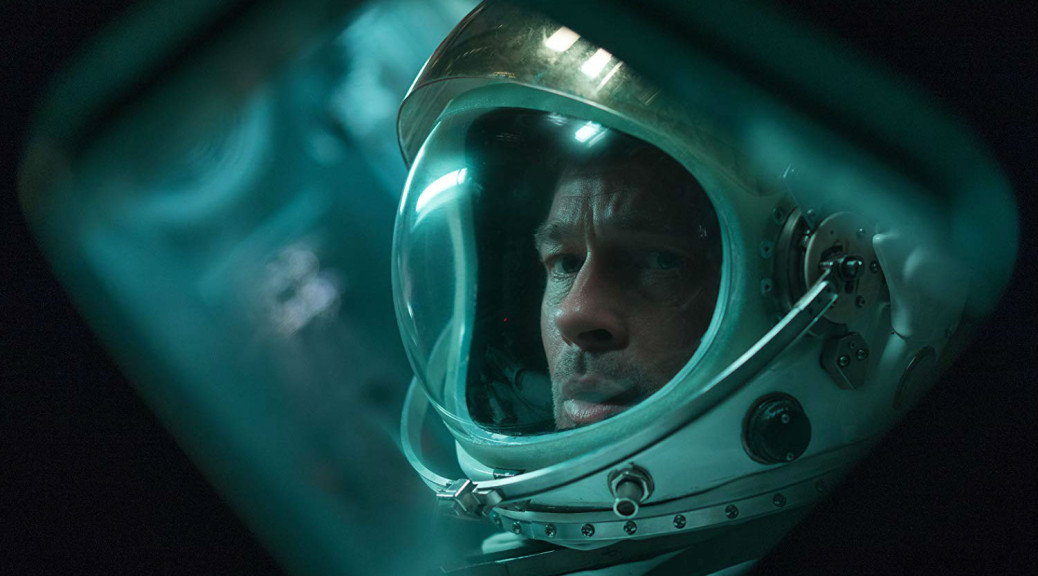“Ad Astra” (PG-13)
Most – but not all – systems are go for “Ad Astra,” writer-director James Gray’s ambitious space drama that blasts off in spectacular fashion but desperately spins out of control at the end. It’s no doubt a spectacular film from an audio-visual standpoint, and the doomsday story line is quite engaging with Brad Pitt in the lead. But as the film nears the end of its two-hour star trek, the plot becomes jumbled and the endgame for the key narrative disappoints.
AUDIO: Hear Tim’s review of “Ad Astra” with Tom Barnard on “The KQ Morning Show” on KQRS-FM. Segment is brought to you by Michael Bryant and Bradshaw & Bryant.
Set in the not-too-distant future, Pitt stars Roy McBride, a highly disciplined but emotionally distant astronaut in a government military organization called U.S. Space Command. Space exploration has advanced significantly in Roy’s lifetime, to the point where his father, Space Command’s top dog Clifford McBride (Tommy Lee Jones), embarked on The Lima Project, a mission to explore the solar system for extraterrestrial life that began when Roy was just a boy. But 16 years into the mission, Clifford disappeared near Neptune.
Thirty years after his father’s disappearance, the adult Roy is working on a mission just above Earth when a sudden electrical storm wreaks havoc on a towering space antenna he is working on, causing death to not only some of his colleagues, but massive fatalities all over the planet. With 40,000 people dead and the entirety of Earth’s population in peril as the electrical storm moves closer, Roy is recruited to embark on an interplanetary mission to contact Neptune, where Space Command believes the phenomena is originating from. Making more matters complicated, Roy’s superiors believe that his father is still alive and may have something to do with the deadly phenomena, and believe the younger McBride may be the only astronaut capable of effectively communicating with him in a bid to stave off the inevitable.
As far as space dramas go, “Ad Astra” feels much more like Christopher Nolan’s 2014 intergalatic epic “Interstellar” than it does the classic “2001: A Space Odyssey,” although there’s no question that “Ad Astra” has a vibe closer to the esoteric Stanley Kubrick film. The thing is, as advanced, technologically, as “2001” and “Interstellar” were at the times of their respective releases, the visual effects seem to have taken an even bigger leap forward as Roy’s ship blasts off, first to a fully operational base on moon before heading to a similarly advanced base on Mars, where Roy is expected to make contact with his father. Thanks to a brilliant IMAX presentation of the film, not only do you feel like you’re strapped into the spaceship with Pitt, you can literally feels the rumbling of the rockets underneath your seat as he takes orbit.
While “Ad Astra” is effectively a story about the strained relationship and hopeful reconciliation between a father and a son, the film, doesn’t wallow entirely in the film’s heady narrative. The action scenes are spectacular, especially when its revealed that colonization is so advanced on the moon that, thanks to the commercialism of space travel, corruption and crime have taken a foothold on the moon, as space pirates attempt to hijack Roy and his crew in a thrilling space buggy chase sequence on the lunar surface. The story also takes some unexpected twists and turns once Roy finds his way to Mars and meets a scientist (Ruth Negga) who reveals a dark secret about The Lima Project.
As much as “Ad Astra” has going for it throughout the movie, it feels discombobulated and ultimately a bit dull as it lumbers toward its ending. Plus, without giving too much away, the final act feels like a cheat as it relates to the all the hoops Roy had to jump through to begin the mission. That’s not to take away from Pitt’s acting, as he delivers yet another solid performance. But while industry tastemakers and fans are already chanting for a Best Actor nomination for Pitt, the performance comes nothing close to his smaller, but far more memorable turn in Quentin Tarantino’s love letter to 1969 Tinseltown, “Once Upon a Time in Hollywood,” a couple months back.
While “Ad Astra” is clearly Pitt’s movie, Jones no doubt has a presence, albeit a small one in the film. One thing’s for certain: Gray gave Pitt, Jones, Negga and Donald Sutherland (who appears in a small turn as Clifford’s former astronaut colleague) far more material to work with than Liv Tyler, who despite being prominently featured in the film’s trailers, barely appears in a stereotypical role as Roy’s resentful wife, who is left out in the cold because of her husband’s vacant emotions.
Lammometer: 7 (out of 10)
Tim Lammers reviews movies weekly for “The KQ92 Morning Show,” WCCO Radio, WJON-AM, KLZZ-FM, “The Tom Barnard Podcast” and “The BS Show” with Bob Sansevere. On TV, Tim has made hundreds of guest appearances on “KARE 11 News at 11” (NBC).
Copyright 2019 DirectConversations.com



